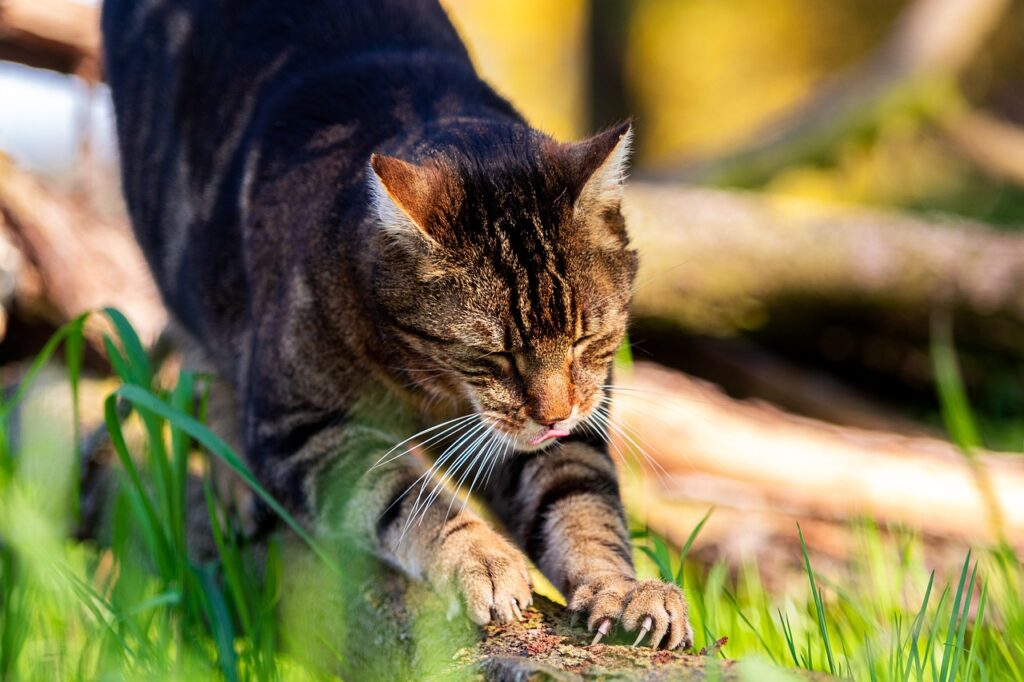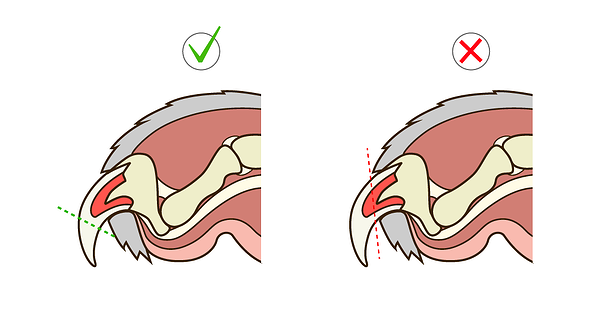An Introduction to Keeping Your Cat’s Claws Trimmed
Cats are known for their sharp claws, which they use for a variety of essential activities, including scratching, climbing, and hunting. While these claws are important for your cat’s physical and mental health, they can also cause them harm if the nails are allowed to become overgrown and can even curl back into the pawpad itself (I have seen this many times and it isn’t pretty). Damage to your furniture, carpets, and even your skin is also a risk factor.
While illegal in New Zealand, declawing is still prevalent in countries like the United States, this procedure is highly unethical and often results in chronic pain, life-long nerve damage and problem behaviours. Without going into too much detail, the equivelent procedure in humans would leave us missing the tops of our fingers (no thank you).
Nail caps are used by people as an ‘alternative’ to declawing, often to protect their home decor and furniture. These caps may stop this damage, but it also prevents the cat from being able to perform their essential daily activities such as climbing, playing, and scratching. This leaves them stressed, frustrated, and may result in additional problematic behaviours. The caps themselves are a safety issue as they can be accidently ingested in an effort to get them off of their claws, sometimes they are even glued on which can cause additional injury and discomfort.
Indoor-only cats who don’t have access to rough concrete and trees that cats with outside access do, often require more frequent trims, along with senior cats who have reduced levels of activity. Regular nail clipping is an essential part of preventative care, but it can be a stressfull task for both you and your feline friend. In today’s post, I’ll provide some tips on how to train your cat to accept (and even enjoy) nail clipping.

- Start Early
The earlier you introduce your cat to nail clipping, the easier it will be to train them. Cats have an optimal learning window from 6-14 weeks of age and this should be taken advantage of. Kittens are generally more receptive to new experiences than adult cats, so it’s important to start introducing them to care tasks like nail clipping when they are young. This will help your cat get used to the feeling of having their paws handled, nails extended out, and reduce the chances of them developing fear or anxiety around nail clipping.
- Gradual Introduction
When introducing your cat to nail clipping, get them used to the sound and presence of the nail clippers before even going near the paws with them, start with short sessions and gradually increase the duration as they become more comfortable. In seperate training sessions practice handling your cat’s paws and gently pressing on the nails to expose them. This will help your cat get used to the sensation and build trust in you. Always keep sessions short, and stop before your cat becomes distressed, reward them during and after the session.
Here’s what a training session might look like with an adult cat who is tolerant of basic handling: Have a Lickimat with some tasty wet food on it on the floor, once they are eating stroke them in an area they enjoy e.g. chin, and without removing your hand move towards a front leg and run your hand down their leg and hold it for 3 seconds. Release the leg, and offer praise while placing a extra treat on the mat. The wet food acts as a distraction and an incentive to stay there, and the extra treat is a reward. Repeat this a few times, stopping before they become agitated or finish their wet food.
- Positive Reinforcement
Positive reinforcement is essential for training your cat to accept nail clipping. Reward your cat with treats, praise, or playtime (whatever your cat enjoys ) after each session to associate nail clipping with positive experiences. This will help your cat feel more comfortable and reduce their anxiety around the task over time. If your pet is on a vet-prescribed diet, have a chat with your vet before introducing any new treats. For cats on a weight loss diet, ensure you reduce their daily food allowance to accommodate the treats given.
- Use the Right Tools
Using the right tools is essential for a successful nail clipping session. Choose a quality set of cat nail clippers that are sharp and easy to handle. There are four main types of clippers including scissor style, plier style, guillotine style, and electric grinder style. I personally prefer to use mini- scissor style clippers such as these small animal nail clippers as they fit my hands well and don’t make much noise. I generally avoid using the electric grinder-style nail tools as the loud noise and vibrations can be very stressful for even the most confident of cats. Make sure to avoid cutting too close to the quick, which is the pink part of the nail that contains blood vessels and nerves (see diagram below). If you accidentally cut the quick, apply a styptic powder (or corn starch in a pinch) to stop the bleeding and reduce pain.

- Respect Your Cat’s Limits
It’s important to respect your cat’s limits when training them to accept any care tasks. Try to keep an eye on your cat’s body language and stop the session before your cat becomes anxious or agitated, remember there is always another day. Never use force to keep your cat ‘in place’ to trim their nails, such as scruffing or pinning them down. This will only reinforce your cat’s aversion to being handled for care tasks, and may even damage their bond with you.
In conclusion, training your cat to accept nail clipping requires the three P’s – patience, persistence, and positive reinforcement. By starting early, using gradual introduction, positive reinforcement, and the right tools, you can help your cat feel more comfortable and reduce their anxiety around the task. Remember to respect your cat’s limits and be gentle and kind throughout the training process. If you are struggling to train your cat to accept care tasks such as nail clipping, don’t hesitate to reach out for help from a a behaviour and training professional such as myself. A fear-free certified mobile vet nurse is another option.
Until next time,
Molly x
Let's Go
Join Me For Free Yoga Classes on InsightTimer
Use this space to advertise your most popular content channel like InsightTimer or YouTube Videos. Put a wee description in here about what you teach.